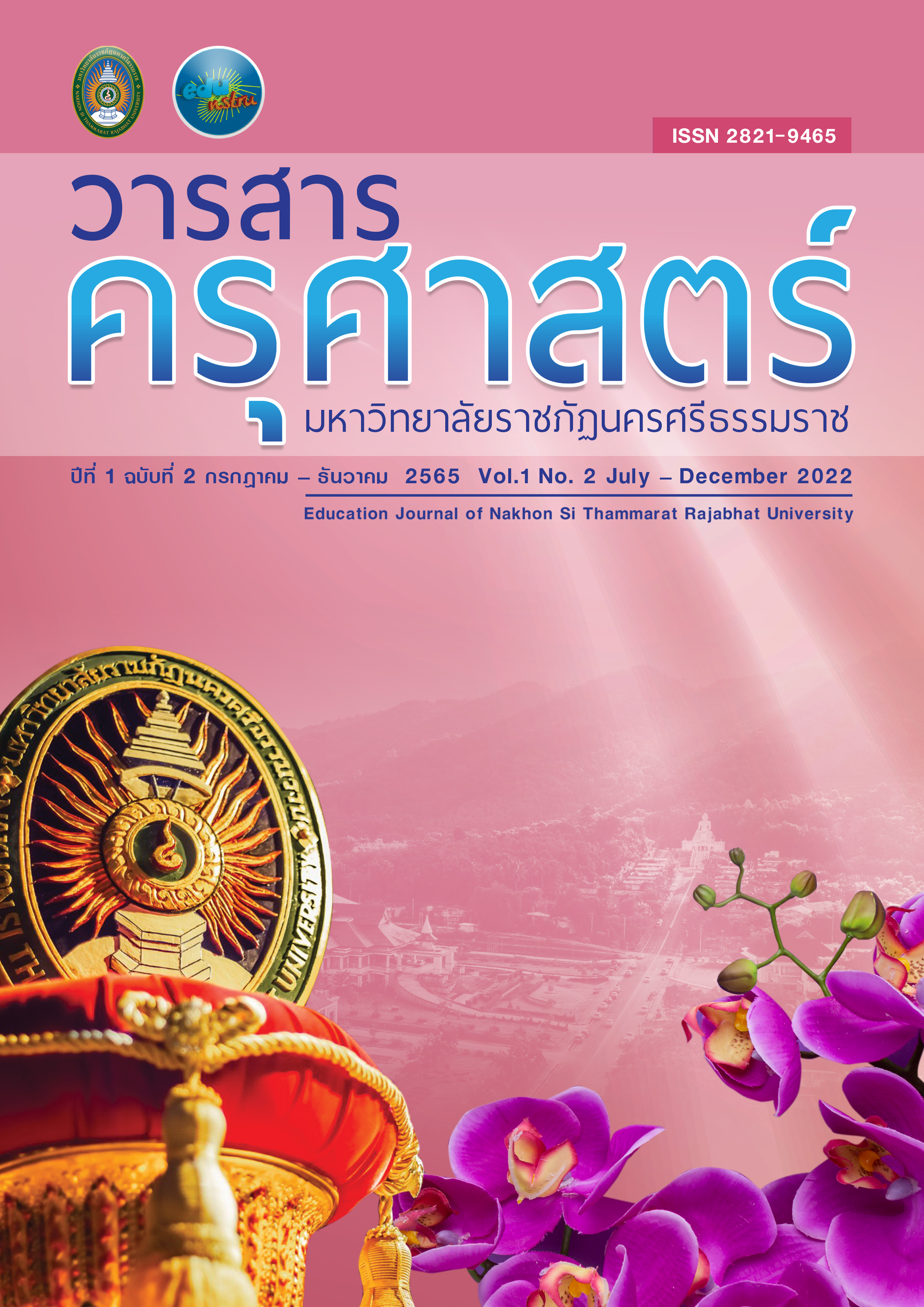The Development of Management Model based on Kaizen Model for Promoting the Desirable Characteristics of Students of Watsakaew School
Main Article Content
Abstract
The purposes of this research were 1) to study the current conditions and the management model based on Kaizen Model to promote desirable characteristics of Watsakaew School’s students, 2) to create the management model based on Kaizen Model to promote desirable characteristics of Watsakaew School’s students, 3) to experiment with the management model, and 4) to assess the management model. The research procedure consisted of four steps as follows. Step 1 was studying the current conditions and concept of the management model based on the Kaizen management model. Step 2 was creating the management model based on Kaizen Model. Step 3 was experimenting with the management model on a simple group, And step 4 was an assessment of the management model. The simple group was from 212 research samples, namely 1 school director, 10 teachers, 7 school board members, 97 Grade 1-6 students and 97 parents. Purposive sampling methods was used for sampling recruitment. Research instruments were interview forms, questionnaires, focus group meeting minutes, the management model based on Kaizen Model and the assessment form for the management model. Data were analyzed by percentage value, mean () standard deviation (S.D.) and content analysis.
Study Resultswas found that 1) the study on current conditions and concept of the management model based on Kaizen Model was at the more level., 2) the result of creating the management model based on Kaizen Model was found that the model was accord and appropriate at the more level., 3) the experimenting result of the management model was found that the management model had promoted student academic achievement and desirable characteristics at the excellent level., and 4) the result of assessment of the management model was found as applicable, possible, appropriate, accurate and satisfactory at the most level.
Article Details

This work is licensed under a Creative Commons Attribution-NonCommercial-NoDerivatives 4.0 International License.
บทความที่ได้รับการตีพิมพ์เป็นลิขสิทธิ์ของวารสารครุศาตร์ มหาวิทยาลัยราชภัฏนครศรีธรราช
ข้อความที่ปรากฏในบทความแต่ละเรื่องในวารสารวิชาการเล่มนี้เป็นความคิดเห็นส่วนตัวของผู้เขียนแต่ละท่านไม่เกี่ยวข้องกับวารสารครุศาสตร์ มหาวิทยาลัยราชภัฏนครศรีธรรมราช
References
จารุวัฒน์ เนตรนิ่ม. (2560). “การปรับปรุงกระบวนการการบริหารสินค้าคงคลังโดยใช้ทฤษฎีไคเซ็น กรณีศึกษา:คลังเครื่องแต่งกาย”, กรมยุทธบริการทหาร กองบัญชาการกองทัพไทย. วารสารสถาบันวิชาการป้องกันประเทศ, 8(1), 96-110.
จิตตินันท์ ดีหลาย. (2561). การศึกษาคุณลักษณะอันพึงประสงค์ของนักเรียน โรงเรียนไสวนันทวิทย์ จังหวัดตราด.การศึกษาค้นคว้าอิสระ ศษ.ม. (การบริหารการศึกษา). กรุงเทพฯ: บัณฑิตวิทยาลัย มหาวิทยาลัยเกริก.
บุญยกุล หัตถกี. (2556). รูปแบบการบริหารคุณภาพการศึกษาสู่ความเป็นเลิศของโรงเรียนขนาดเล็ก[วิทยานิพนธ์ กศ.ด. การบริหารการศึกษา ชลบุรี: บัณฑิตวิทยาลัย มหาวิทยาลัยบูรพา].
พนิดา หวานเพ็ชร. (2555). การเพิ่มประสิทธิภาพการทำงานโดยใช้แนวคิดไคเซ็น : กรณีศึกษาแผนกบัญชีค่าใช้จ่าย.[วิทยานิพนธ์ บธ.ม. การจัดการวิศวกรรมธุรกิจ ปทุมธานี: บัณฑิตวิทยาลัย มหาวิทยาลัยเทคโนโลยีราชมงคลธัญบุรี].
ไมตรี บุญทศ. (2554). การพัฒนารูปแบบการบริหารเพื่อการประกันคุณภาพภายในที่ส่งผลต่อคุณภาพ โรงเรียนสังกัดสำนักงานคณะกรรมการการศึกษาขั้นพื้นฐาน [วิทยานิพนธ์ ค.ด. บริหารการศึกษา อุบลราชธานี: บัณฑิตวิทยาลัย มหาวิทยาลัยราชภัฏอุบลราชธานี].
โรงเรียนวัดสระแก้ว. (2562). รายงานประจำปีของสถานศึกษา (Self-Assessment Report: SAR) ปีการศึกษา 2562. นครศรีธรรมราช: สำนักงานเขตพื้นที่การศึกษาประถมศึกษานครศรีธรรมราช เขต 1 โรงเรียนวัดสระแก้ว.
วิฑูรย์ สิมะโชคดี. (2560). TQM คู่มือพัฒนาองค์กรสู่ความเป็นเลิศ. กรุงเทพฯ: เนชั่นบุ๊คส์.
วิทยา ตันสุวรรณนนท์. (2550). การพัฒนาระบบคุณภาพ การปรับปรุงด้วย “ไคเซ็น”. กรุงเทพฯ: สมาคมส่งเสริมเทคโนโลยี (ไทย-ญี่ปุ่น).
สถาบันเพิ่มผลผลิตแห่งชาติ. (2552). คู่มือดำเนินกิจกรรม 5ส โครงการส่งเสริมผลผลิตราชการสถาบันเพิ่มผลผลิตแห่งชาติ. พิมพ์ครั้งที่ 2. กรุงเทพฯ: สมาคมส่งเสริมเทคโนโลยี (ไทย-ญี่ปุ่น).
สมชัย จรรยาไพบูลย์. (2555). รูปแบบการพัฒนาการประกันคุณภาพภายในสถานศึกษา สังกัดสำนักงาน เขตพื้นที่การศึกษามัธยมศึกษา เขต 29 [วิทยานิพนธ์ ค.ด.บริหารการศึกษา อุบลราชธานี: บัณฑิตวิทยาลัย มหาวิทยาลัยราชภัฏอุบลราชธานี].
สมยงค์ แก้วสุพรรณ. (2552). รูปแบบการบริหารสถานศึกษาขั้นพื้นฐานที่มีประสิทธิผลเพื่อการประกันคุณภาพการศึกษา [วิทยานิพนธ์ ปร.ด. ยุทธศาสตร์การพัฒนาภูมิภาค มหาสารคาม: บัณฑิตวิทยาลัย มหาวิทยาลัยมหาสารคาม].
สมาพร ลี้ภัยรัตน์, ธานี เกสทอง และนันทิยา น้อยจันทร์. (2560) รูปแบบการบริหารคุณภาพโรงเรียนมาตรฐานสากลระดับประถมศึกษา. วารสารสุทธิปริทัศน์, 31(100), 261-273.
สำนักงานเลขาธิการสภาการศึกษา. (2562). มาตรฐานการศึกษาของชาติ พ.ศ. 2561. กรุงเทพฯ: บริษัท21 เซ็นจูรี่ จำกัด.
สำนักงานเลขาธิการสภาการศึกษา. (2559). รายงานสภาวะการศึกษาไทย ปี 2557/2558 จะปฏิรูปการศึกษาไทยให้ทันโลกในศตวรรษที่ 21 ได้อย่างไร. กรุงเทพฯ: บริษัทพิมพ์ดีการพิมพ์ จำกัด.
สุทัศน์ เมืองมนประเสริฐ. (2558). ความสัมพันธ์ของกิจกรรมไคเซ็นแบบกลุ่มควบคุมคุณภาพกับจำนวน ผลผลิต, จำนวนของเสีย และทัศนคติการทำงานเป็นทีม: กรณีศึกษาบริษัท ทียูดับบลิว เท็กซ์ไทล์ จำกัด.[วิทยานิพนธ์ บธ.ม. กรุงเทพฯ: บัณฑิตวิทยาลัย มหาวิทยาลัยศิลปากร].
สุภรัตน์ พูนสวัสดิ์. (2559). การเพิ่มประสิทธิภาพการทางานของแผนกเอกสารขาออก กรณีศึกษาสายเรือแห่งหนึ่งในเขตพื้นที่แหลมฉบัง [งานนิพนธ์ วท.ม. การจัดการโลจิสติกส์และโซ่อุปทาน ชลบุรี: บัณฑิตวิทยาลัย มหาวิทยาลัยบูรพา].
สุลภัส เครือกาญจนา. (2552). เพิ่มประสิทธิภาพการทำงานด้วยไคเซ็น. พิมพ์ครั้งที่ 6. กรุงเทพฯ: สมาคมส่งเสริมเทคโนโลยี ไทย-ญี่ปุ่น.
Bamkin, S. (2016). Moral Education at Japanese elementary school. London: Winston Churchill Memorial Trust.
Patimah, S. (2017). Leadership Styles, Motivation Achievers and Quality in Cultural Teaching. European Research Studies Journal, 3A, 278-290.

